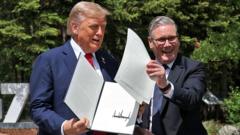With extensive mineral reserves and rising global demand, Greenland finds itself at the center of a race for resources. As mining companies eye its potential, questions about environmental impact, economic independence, and local benefit loom large in discussions of the island’s future.
Greenland's Mineral Wealth: A New Frontier in Global Resource Competition

Greenland's Mineral Wealth: A New Frontier in Global Resource Competition
Amid heightened geopolitical interest, Greenland's untapped mineral resources are attracting global attention, posing questions about the territory’s economic future.
Article Text:
In recent years, Greenland has emerged as a focal point in the global scramble for mineral resources, boasting vast untapped reserves crucial for modern technology and energy solutions. The island, an autonomous territory of Denmark, controls its natural resources but remains under the influence of larger nations keen to secure a foothold amid growing geopolitical tension.
Eldur Olafsson, CEO of Amaroq Minerals, illustrates the potential of this icy land during a journey through its pristine wilderness. “This landscape is a gold belt,” he declares, as his team explores mountains rich in minerals. Their search includes valuable commodities such as copper, nickel, and rare earth elements—materials that are essential in manufacturing everything from smartphones to renewable energy technologies.
Despite its promising mineral wealth, Greenland’s economic landscape remains challenging, driven primarily by the public sector and fishing industries. The exploration licenses granted in the past five years signal a growing interest from foreign mining firms, yet only two active mines exist on its vast territory. With an annual GDP just surpassing $3 billion and reliance on a $600 million subsidy from Denmark, mining holds potential for transforming the local economy and reducing dependency on external funding.
However, obstacles remain. Geographical isolation, adverse weather conditions, and stringent environmental regulations complicate efforts to establish new mines. Furthermore, skepticism persists among local communities about whether mining will genuinely benefit them. Residents question whether jobs will be accessible to Greenlanders or whether profits will primarily benefit international investors.
The global demand for minerals, particularly due to the clean energy transition, has intensified interest from Western nations looking for alternatives to China's dominant position in rare earth supplies. As ambassadors of business interests convey a message of potential partnership, Greenland's government remains cautious yet hopeful about the path forward in mining development.
In this high-stakes environment, discussions about Greenland’s resources dovetail with broader geopolitical narratives. U.S. President Donald Trump’s comments on potential American interest in Greenland have raised questions about sovereignty, economic security, and national interests. While Greenland's Prime Minister, Mute Egede, expresses a desire for fruitful ties with the U.S., the prospect of foreign control raises local concerns about the balance between economic growth and preservation of cultural identity.
As Greenland treads the line between harnessing its mineral assets and ensuring meaningful benefits for its people, the coming years promise to be crucial. Will increased mining activity bolster economic independence while simultaneously safeguarding local interests? As the world watches, Greenland stands poised at a crossroads, with its mineral wealth potentially leading to either prosperity or further challenges.
In recent years, Greenland has emerged as a focal point in the global scramble for mineral resources, boasting vast untapped reserves crucial for modern technology and energy solutions. The island, an autonomous territory of Denmark, controls its natural resources but remains under the influence of larger nations keen to secure a foothold amid growing geopolitical tension.
Eldur Olafsson, CEO of Amaroq Minerals, illustrates the potential of this icy land during a journey through its pristine wilderness. “This landscape is a gold belt,” he declares, as his team explores mountains rich in minerals. Their search includes valuable commodities such as copper, nickel, and rare earth elements—materials that are essential in manufacturing everything from smartphones to renewable energy technologies.
Despite its promising mineral wealth, Greenland’s economic landscape remains challenging, driven primarily by the public sector and fishing industries. The exploration licenses granted in the past five years signal a growing interest from foreign mining firms, yet only two active mines exist on its vast territory. With an annual GDP just surpassing $3 billion and reliance on a $600 million subsidy from Denmark, mining holds potential for transforming the local economy and reducing dependency on external funding.
However, obstacles remain. Geographical isolation, adverse weather conditions, and stringent environmental regulations complicate efforts to establish new mines. Furthermore, skepticism persists among local communities about whether mining will genuinely benefit them. Residents question whether jobs will be accessible to Greenlanders or whether profits will primarily benefit international investors.
The global demand for minerals, particularly due to the clean energy transition, has intensified interest from Western nations looking for alternatives to China's dominant position in rare earth supplies. As ambassadors of business interests convey a message of potential partnership, Greenland's government remains cautious yet hopeful about the path forward in mining development.
In this high-stakes environment, discussions about Greenland’s resources dovetail with broader geopolitical narratives. U.S. President Donald Trump’s comments on potential American interest in Greenland have raised questions about sovereignty, economic security, and national interests. While Greenland's Prime Minister, Mute Egede, expresses a desire for fruitful ties with the U.S., the prospect of foreign control raises local concerns about the balance between economic growth and preservation of cultural identity.
As Greenland treads the line between harnessing its mineral assets and ensuring meaningful benefits for its people, the coming years promise to be crucial. Will increased mining activity bolster economic independence while simultaneously safeguarding local interests? As the world watches, Greenland stands poised at a crossroads, with its mineral wealth potentially leading to either prosperity or further challenges.





















